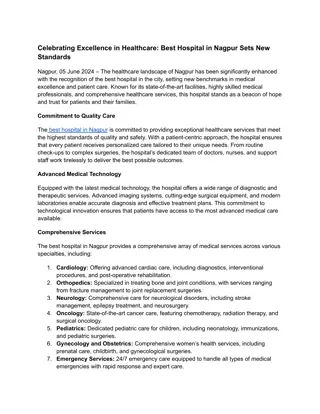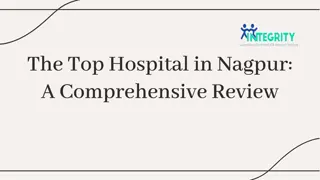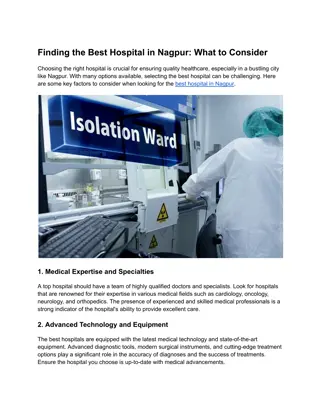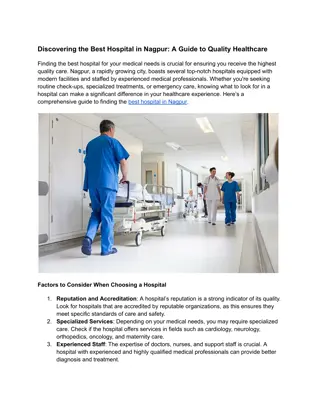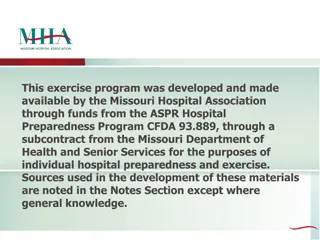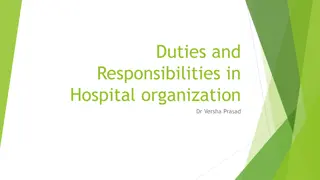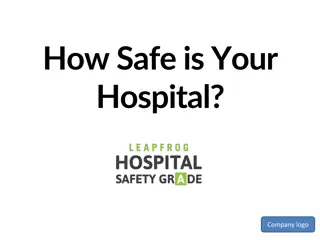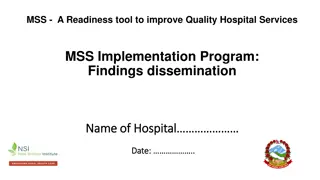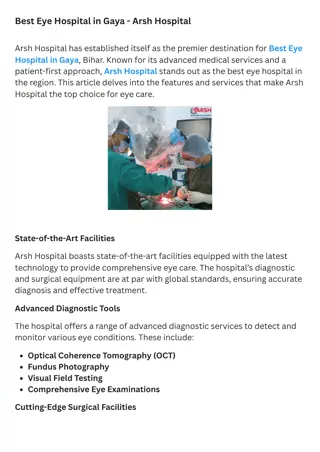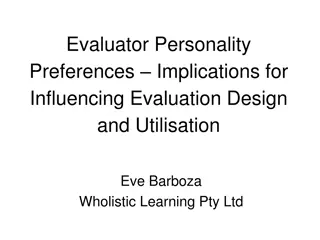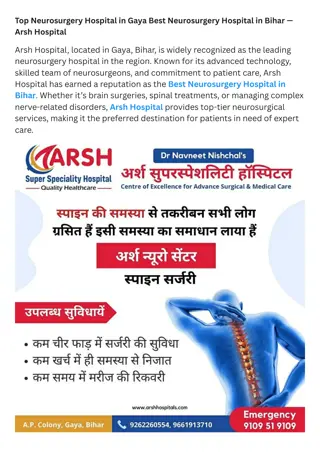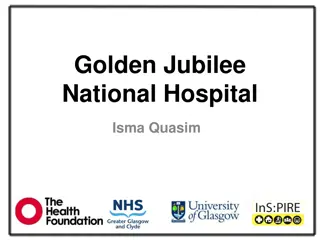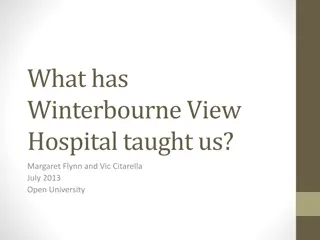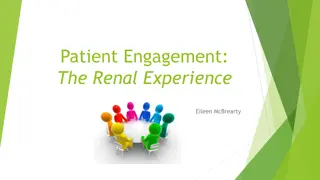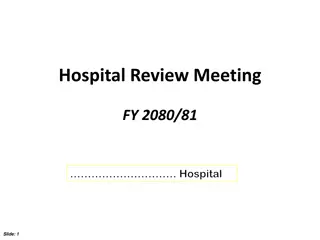Understanding Public Hospital Patient Preferences for Quality and Choice in Australia
The study explores whether Australian public hospital patients would choose a higher quality hospital if given the option. Through a discrete choice experiment, researchers investigate if patients prioritize quality over convenience when selecting public hospitals for elective surgeries. Findings reveal insights into Australians' preferences and perceptions towards hospital characteristics in the healthcare system.
Download Presentation

Please find below an Image/Link to download the presentation.
The content on the website is provided AS IS for your information and personal use only. It may not be sold, licensed, or shared on other websites without obtaining consent from the author. Download presentation by click this link. If you encounter any issues during the download, it is possible that the publisher has removed the file from their server.
E N D
Presentation Transcript
Will public hospital patients choose a better quality hospital given the choice? A discrete choice experiment AHES Conference 2017 Yuanyuan Gu, PhD Senior Research Fellow Co authors: Henry Cutler, PhD Director Emma Olin Research Fellow CENTRE FOR THE HEALTH ECONOMY
Introduction Background and study objectives
Background Australia has a mixed public-private hospital system, with around 34% of elective surgery undertaken in public hospitals This has resulted in different access to hospital care based on ability to pay (private health insurance and co-payments) Private patients have absolute choice over hospital and surgeon / specialist. Public patients have virtually no choice. The Australian Government is currently exploring the potential to introduce greater choice into Human Services (incl. public hospitals) CENTRE FOR THE HEALTH ECONOMY 3
Study objectives Would Australians exercise their right to choose a public hospital based on quality vs. convenience? To elicit Australians preferences for hospital characteristics in the context of elective surgery. CENTRE FOR THE HEALTH ECONOMY 4
Methodology Survey and discrete choice experiment
A national survey 1,000 Australians aged 50 to 75 years representative by age and gender recruited through Toluna Australia via the Internet A discrete choice experiment (DCE) presented 12 hypothetical scenarios with two hospitals made up of seven attributes with four levels each Respondents were asked to choose their most preferred hospital, implicitly revealing their value for attribute levels. A survey asked questions regarding socioeconomic characteristics, health literacy (self-assessed), attitudes towards the health care system CENTRE FOR THE HEALTH ECONOMY 6
DCE setting Please imagine that you have developeda hip problem. As a result, each day you have some problems walking about, some problems with performing your usual activities (e.g. work, study, housework, family or leisure activities) and experience moderate pain and discomfort. Please also imagine that you have ratedyour health state at 65on a scale from 0-100, where the best health you can imagine is 100 (i.e. no problems walking about, no problems with performing usual activities, and no pain and discomfort), and the worst health you can imagine is 0, which is equivalent to death. Before your hip problem, you had ratedyour health state at 80, which was also the average self-reported health for all people aged between 55-75 years old. Please imagine that your GP has referred you to a specialist. The specialist recommends you undergo elective hip replacement surgery within90 days, which is categorised assemi-urgent. Other categories could have included urgent (within 30 days) and non-urgent (within 365 days). After surgery, typically you will be hospitalised for 3-8 days. CENTRE FOR THE HEALTH ECONOMY 7
Attributes Convenience represented by two attributes: Distance form home to the hospital Waiting time for elective surgery (levels differ across urgency category) Opinions represented by two attributes GP s opinion of hospital quality Other patients overall rating of the hospital Quality represented by three attributes Average patient reported health gain six months after surgery Rate of adverse events Readmission rate within 28 days after surgery CENTRE FOR THE HEALTH ECONOMY 8
Example choice set CENTRE FOR THE HEALTH ECONOMY 10
Discrete choice experiment results Preferences for choice attributes
Analysis of responses Conditional logit was used to analyse survey responses. Observed heterogeneity measured using interactions Forced choice and unforced choice models were compared, with similar results. Unforced choice used given it better represents reality Relative importance of attribute levels measured by calculating the change in probability of choosing hospital when one attribute level changes, while all other attribute levels remain fixed CENTRE FOR THE HEALTH ECONOMY 12
Summary of results Respondents value all attributes when choosing between hospitals. They are willing to trade off all attributes with each other Respondents value hospital quality the most, as measured by reduced adverse events, readmission and potential health gain Respondents value a GP s opinion and other patient experiences equally Respondents are risk averse when choosing hospitals. They trade off potential health gains to avoid an adverse event or readmission CENTE FOR THE HEALTH ECONOMY 13
Summary of results Respondents trade off less convenience for better quality. They are willing to travel further and wait longer for a better quality hospital Surgical urgency impacts the value of convenience attributes only. The more urgent, the more valued are shorter distances and shorter waiting times. CENTRE FOR THE HEALTH ECONOMY 14
Relative attribute importance Semi-urgent Non-urgent 0.35 0.35 Impact of specific attribute levels 0.30 0.30 Impact of specific attribute levels 0.25 0.25 0.20 0.20 0.15 0.15 0.10 0.10 0.05 0.05 0.00 0.00 distance2 distance3 distance4 gp3 adverse3 adverse4 time2 time3 time4 gp2 gp4 patient2 adverse2 patient3 patient4 gain2 readmin2 readmin3 readmin4 gain3 gain4 distance2 distance3 distance4 time2 gp3 adverse2 gp4 patient3 adverse3 adverse4 time3 time4 gp2 patient2 patient4 readmin2 gain3 gain4 gain2 readmin3 readmin4 -0.05 Least important Most important Least important Most important CENTRE FOR THE HEALTH ECONOMY 15
Observed preference heterogeneity Female respondents dislike a hospital more when a GP rates the hospital as poor Respondents living outside major cities are more willing to travel longer distances to attend a better quality hospital Respondents with year 12 or below education are more willing to choose a hospital with lower health gain (value health improvement less) Respondents with past elective surgery experience are more willing to choose a hospital with lower health gain CENTRE FOR THE HEALTH ECONOMY 16
Policy implications Considerations for introducing greater choice
Policy implications Patients must value quality and exercise their right to choose for increased patient choice to improve public hospital quality Public hospitals must respond to quality signals from patient choice Government will need to facilitate both these necessary conditions CENTRE FOR THE HEALTH ECONOMY
Thank you Dr Yuanyuan Gu Yuanyuan.Gu@mq.edu.au END This research project was joint funded through funding provided by Macquarie University and the Commonwealth Bank of Australia. Neither Macquarie University or the Commonwealth Bank of Australia had any input into the study design, data collection, interpretation of results, or conclusions.
Policy implications Improve hospital quality information Purposefully determined to ensure best way to represent and present attributes Avoid potential perverse incentives from published quality information Provide assistance to patients when making their choice Patients may rely on choice heuristics. 60% of Australians have low health literacy 85% of respondents would involve a GP in their decision Reduce barriers (switching costs) to exercising choice Travel distance and waiting times have a financial cost and opportunity cost Patients may face an implicit budget constraint to choice Help hospitals respond to patient preferences for quality Accommodate shifts in patient demand (funding, workforce, infrastructure) Better performance frameworks to identify quality blackspots in hospitals CENTRE FOR THE HEALTH ECONOMY













